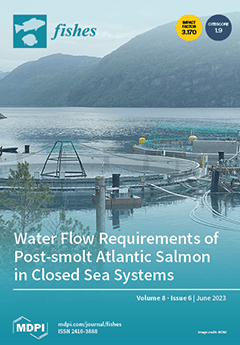Species of the genus
Pseudoplatystoma, the long-whiskered catfishes, are important in commercial and recreational fisheries in South America, and some species have become key to regional aquaculture. Some species of the genus are under pressure due to overfishing and the negative impacts
[...] Read more.
Species of the genus
Pseudoplatystoma, the long-whiskered catfishes, are important in commercial and recreational fisheries in South America, and some species have become key to regional aquaculture. Some species of the genus are under pressure due to overfishing and the negative impacts of dams. Six questions are asked in this review: (i) What species are in the genus, and where are they distributed? (ii) What are the life histories and ecologies of
Pseudoplatystoma species? (iii) What are the patterns of somatic growth for these species? (iv) What is known about the biomass, production, and population dynamics of
Pseudoplatystoma? (v) What is the geographic distribution of genetic variation within
Pseudoplatystoma species? (vi) What are the threats to the conservation of these species? The taxonomy of the genus currently includes eight species, respectively, distributed over the Orinoco, Amazon, Paraná, and São Francisco basins.
Pseudoplatystoma catfishes typically exhibit longitudinal migrations for reproduction and lateral migration for feeding, but these patterns may vary among populations. The size of the first maturation of these catfishes varies between 57 cm to 82 cm in total length. Five of the eight species spawn during the rising water season.
Pseudoplatystoma species can grow to about 130 cm in total length and 100 Kg in weight and live until 30 years of age, depending upon the species. Biomass production and population dynamics of these catfishes have not yet been fully described. Their life-history characteristics indicate that they are periodic strategists with associated population recruitment dynamics. Population genetic patterning varies among
Pseudoplatystoma species, with some degree of homing behavior and genetic differentiation among populations, indicating the need for management by applying the Management Unit and perhaps Evolutionary Significant Unit concepts. The main threats to the persistence of these catfishes are overfishing and alterations in and obstruction of river flow due to the construction of hydropower dams. After synthesizing existing information on species of the genus
Pseudoplatystoma, we offer suggestions for future research to fill critical gaps in the knowledge of this group.
Full article





